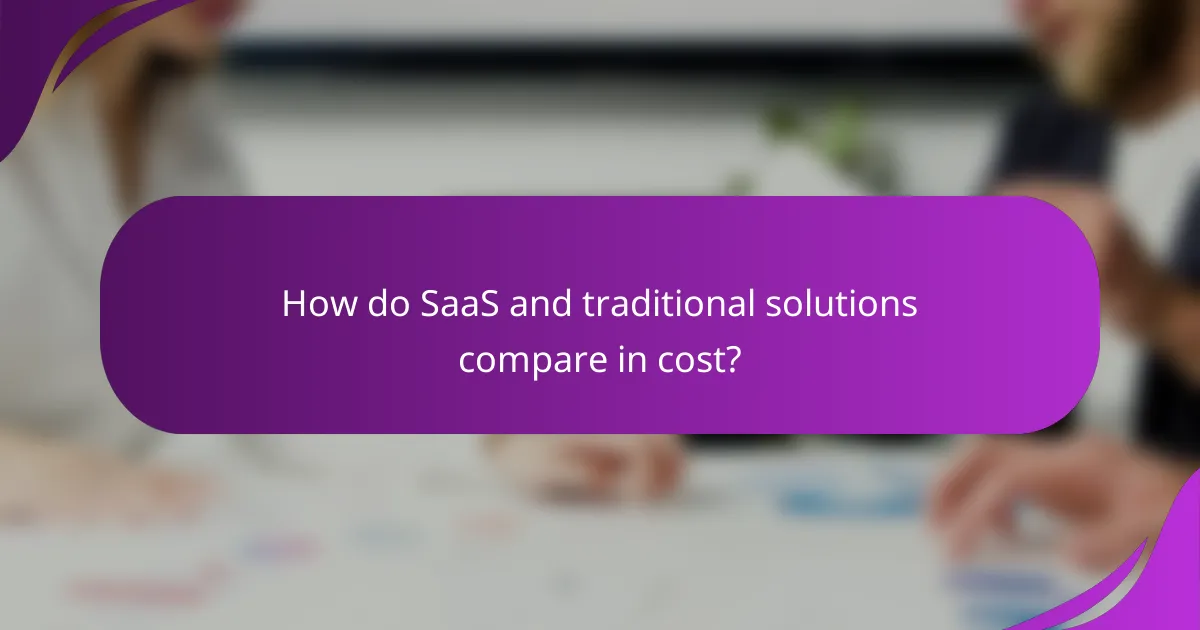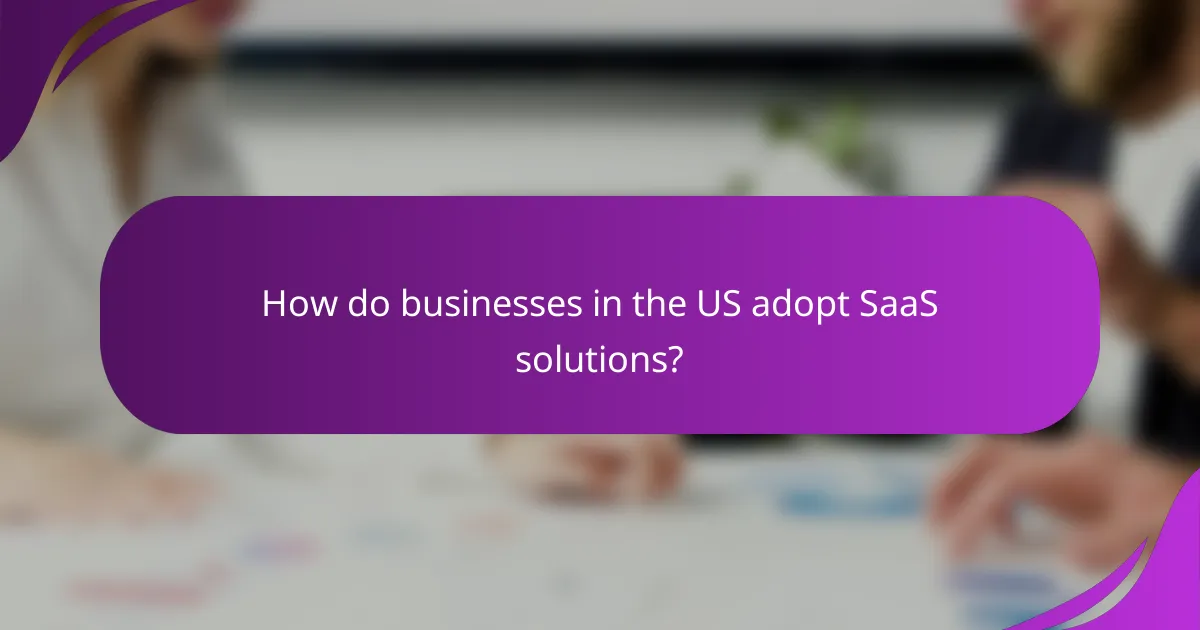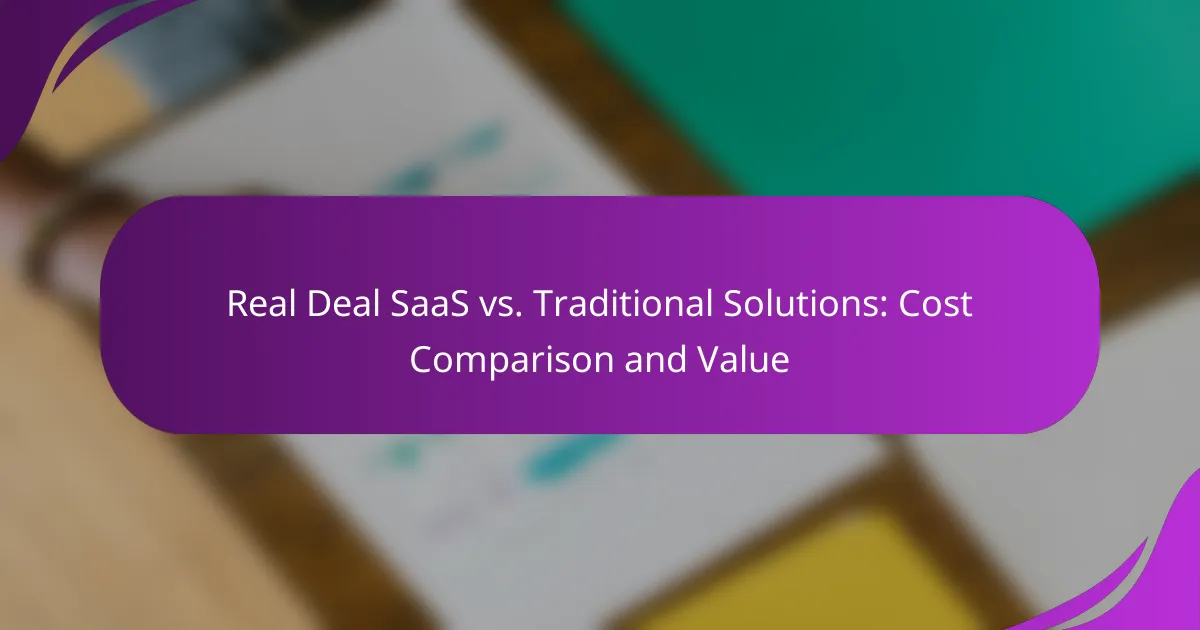In today’s rapidly evolving business landscape, the choice between SaaS (Software as a Service) and traditional software solutions can significantly impact a company’s financial health and operational efficiency. SaaS typically provides a more flexible and predictable cost structure, allowing businesses to manage expenses through subscription-based payments rather than hefty upfront investments. This approach not only facilitates quicker deployment but also enables companies to scale their services according to their evolving needs.

How do SaaS and traditional solutions compare in cost?
SaaS (Software as a Service) typically offers a more flexible and predictable cost structure compared to traditional software solutions. While traditional solutions often require significant upfront investment, SaaS allows for subscription-based payments that can be more manageable for businesses.
SaaS subscription models
SaaS subscription models generally involve monthly or annual fees that grant users access to the software. These fees can vary based on factors such as the number of users, features included, and service levels. For instance, a basic plan might start at around $10 per user per month, while more comprehensive plans can exceed $100 per user per month.
Additionally, many SaaS providers offer tiered pricing, allowing businesses to choose a plan that fits their needs. This flexibility can help organizations scale their software usage as they grow, avoiding the need for costly upgrades associated with traditional software.
Traditional software licensing fees
Traditional software typically requires a one-time licensing fee, which can range from hundreds to thousands of dollars depending on the software and the number of licenses purchased. This upfront cost can be a barrier for some businesses, especially smaller ones or startups.
Moreover, traditional solutions often involve additional costs for upgrades, maintenance, and support, which can add up over time. Companies must budget not only for the initial purchase but also for ongoing expenses related to hardware and IT support.
Hidden costs of traditional solutions
Hidden costs associated with traditional software can significantly impact the total cost of ownership. These may include expenses for hardware, installation, and ongoing maintenance, which can be substantial. For example, businesses may need to invest in servers or specialized IT personnel to manage the software.
Furthermore, traditional solutions may require periodic upgrades that necessitate additional spending, both in terms of software and potential hardware updates. These unexpected costs can lead to budget overruns and financial strain.
Long-term savings with SaaS
Over time, SaaS can provide significant savings compared to traditional solutions. The subscription model eliminates large upfront costs and spreads expenses over time, making budgeting easier. Additionally, SaaS providers often include updates and support in their fees, reducing the need for separate maintenance budgets.
Businesses can also benefit from lower operational costs, as SaaS solutions typically require less IT infrastructure and personnel. This can lead to more efficient use of resources and a better return on investment in the long run.

What are the key benefits of SaaS over traditional solutions?
SaaS, or Software as a Service, offers several advantages over traditional software solutions, primarily in cost, flexibility, and ease of use. Businesses can benefit from lower upfront costs, quicker deployment, and the ability to scale services according to their needs.
Scalability of SaaS platforms
SaaS platforms are designed to scale easily, allowing businesses to adjust their usage based on demand. This means companies can start with a small number of users and expand as their needs grow, without the need for significant infrastructure investments.
For example, a small startup can begin with a few licenses and upgrade to hundreds as they grow, often with just a few clicks. This flexibility helps avoid the pitfalls of overcommitting resources upfront, which is common with traditional software solutions.
Accessibility and remote collaboration
One of the major benefits of SaaS is its accessibility from any device with an internet connection, facilitating remote collaboration. Teams can work together in real-time, regardless of their physical locations, which is increasingly important in today’s work environment.
For instance, tools like Google Workspace or Microsoft 365 allow multiple users to edit documents simultaneously, enhancing productivity and communication. This level of accessibility is often not possible with traditional software that requires installation on specific devices.
Automatic updates and maintenance
SaaS solutions typically include automatic updates and maintenance, relieving businesses of the burden of managing software upgrades. This ensures that users always have access to the latest features and security patches without needing to allocate IT resources for manual updates.
In contrast, traditional software often requires scheduled updates, which can lead to downtime and potential security vulnerabilities. With SaaS, updates happen seamlessly, allowing users to focus on their work rather than software management.

What factors influence the cost of SaaS solutions?
The cost of SaaS solutions is influenced by various factors including pricing models, subscription plans, and integration costs. Understanding these elements helps businesses make informed decisions about their software investments.
Usage-based pricing models
Usage-based pricing models charge customers based on their actual usage of the software, which can be beneficial for businesses with fluctuating needs. This model allows companies to pay only for what they consume, making it potentially cost-effective during low-usage periods.
However, businesses should monitor usage closely to avoid unexpected spikes in costs. For example, if a company uses a SaaS product for data storage, increased data usage could lead to significantly higher monthly fees.
Tiered subscription plans
Tiered subscription plans offer different levels of service at varying price points, allowing businesses to choose a plan that best fits their requirements. These plans typically include a set number of features and user licenses, with higher tiers providing additional capabilities.
When selecting a tier, consider both current and future needs. Opting for a higher tier may provide more value if you anticipate growth, while a lower tier might suffice for smaller operations. Always review the features included in each tier to ensure you are not paying for unnecessary extras.
Integration costs with existing systems
Integration costs can significantly impact the overall expense of adopting a SaaS solution. These costs arise when connecting the new software with existing systems, which may require additional tools or services to ensure seamless operation.
To minimize integration costs, assess compatibility with current systems before selecting a SaaS provider. Some vendors offer built-in integrations that can reduce expenses, while others may require custom development, which can be costly. Always factor these potential costs into your total budget when evaluating SaaS options.

What are the limitations of traditional solutions?
Traditional solutions often face significant limitations that can hinder their effectiveness and adaptability. These challenges include high upfront costs, ongoing maintenance issues, and a lack of flexibility in customization.
High upfront investment
One of the main drawbacks of traditional solutions is the high upfront investment required. Businesses typically need to allocate substantial funds for hardware, software licenses, and implementation services, which can range from thousands to millions of dollars depending on the scale of the solution.
This initial cost can be a barrier for small to medium-sized enterprises (SMEs) that may not have the capital to invest upfront. Additionally, the long-term financial commitment can strain budgets, especially if the expected return on investment (ROI) takes longer to materialize than anticipated.
Maintenance and support challenges
Traditional solutions often require ongoing maintenance and support, which can be both costly and time-consuming. Organizations may need to hire dedicated IT staff or contract external support services to ensure systems remain operational and secure.
These maintenance costs can accumulate over time, leading to unexpected expenses. Furthermore, if a system fails, the downtime can disrupt business operations, resulting in lost revenue and productivity.
Limited flexibility and customization
Another limitation of traditional solutions is their restricted flexibility and customization options. Many systems are designed with a one-size-fits-all approach, making it difficult for businesses to tailor functionalities to their specific needs.
This lack of adaptability can lead to inefficiencies, as organizations may have to work around the system’s limitations rather than optimizing their processes. In contrast, more modern solutions, such as SaaS, often provide greater customization and scalability, allowing businesses to adjust their tools as they grow.

How do businesses in the US adopt SaaS solutions?
Businesses in the US adopt SaaS solutions by transitioning from traditional software to cloud-based applications. This shift often involves evaluating needs, selecting appropriate services, and integrating them into existing workflows.
Trends in SaaS adoption
Recent trends indicate a significant increase in SaaS adoption among US businesses, driven by the need for flexibility and cost-effectiveness. Many organizations are moving towards subscription-based models, which allow for easier scaling and reduced upfront costs.
Industries such as healthcare, finance, and education are leading the way in SaaS implementation, utilizing cloud solutions for everything from data management to customer relationship management. This trend reflects a broader acceptance of digital transformation across various sectors.
As companies adopt SaaS, they often prioritize security and compliance, ensuring that their chosen solutions meet industry standards. Regular assessments and updates are crucial to maintaining data integrity and protecting sensitive information.
